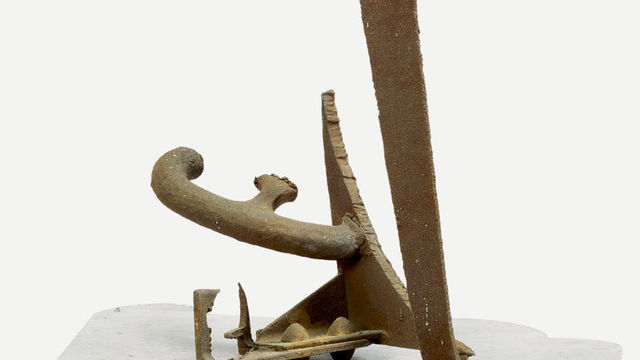
Mark di Suvero
Mark di Suvero was born in Shanghai, where his father was serving as a naval attaché for the Italian government. He immigrated with his family to San Francisco in 1941 and began to thrive artistically while a student at the University of California, Santa Barbara. He transferred to the University of California, Berkeley, graduating in 1957 with a bachelor's degree in philosophy; he moved to New York shortly thereafter. Although a serious spinal injury on the site of his part-time construction job in 1960 kept him confined to a wheelchair for two years, he spent the time refining his skills and creating freely modeled, smaller-scale sculptures that incorporated steel, picking up a welding technique that he would continue to use in his larger pieces.
From the mid-1960s on, di Suvero, invigorated by the changing city, began to create larger forms out of objects taken from construction and salvage sites. His choice of found materials and use of an industrial crane as an artist's tool had a major impact on John Outterbridge, whose Containment Series developed out of a working relationship with the artist. While di Suvero's smaller works often use cast-off pieces of steel, his monumentally scaled sculptures are made primarily from industrial I-beams bolted or welded together. Geometry and structure play an important role in these constructions, much like the basic principles of architecture. Grounded in the practices of abstract expressionism that had dominated the New York art scene at his arrival, di Suvero engages space, line, and color to energize a work.
Space plays an important role in all of di Suvero's art. Expanding beyond purely horizontal or vertical planes, he creates diagonals, pyramids, and ellipses that punctuate the landscape. Sharp and rounded corners exist side by side, as do an array of lines—jagged, curved, and straight. The resulting sculptures, whether large or small, dominate and activate the spaces they occupy, and, like the kinetic mobiles of Alexander Calder, they employ physics by drawing on the effects of time and motion. Di Suvero also incorporates his interests in fields as diverse as science, math, literature, and music. In addition to musical references in his titles, such as Homage to Charlie Parker (1975), the artist plays with the musical qualities of his medium, providing hammers for people to bang on the sculptures or utilizing the wind to create chiming sounds.
Although usually visually imposing, di Suvero's works are often participatory, inviting viewers to scale or even swing on and ride them. By walking around, through, under, or on top of a work, the viewer experiences the sculpture's geometry and structural engineering as well as its surrounding elements—air, wind, vegetation, other people. What results is not simply an engagement with a steel form but a greater understanding of the world and one's interaction with it.
A politically conscious artist, in 1966 di Suvero designed and built the Artists' Tower of Protest in Los Angeles, with architect Kenneth H. Dillon, to oppose U.S. involvement in Vietnam. Nearly sixty feet high, the Peace Tower, as it came to be known, was a collaborative project organized by the Artists Protest Committee. Sculptors such as Melvin Edwards contributed to its construction, and on its armature were hung more than four hundred paintings donated by artists, including Betye Saar and Charles White. It stood for three months as a powerful symbol of antiwar sentiment.
Di Suvero has long been committed to helping his fellow artists. He cofounded Park Place Gallery in New York in 1963 to exhibit the work of emerging artists. The gallerist Paula Cooper served as president and, later, director. In 1977 di Suvero established the Athena Foundation and in 1986, Socrates Sculpture Park, a vast exhibition space, open studio, and community park in Queens, New York.
—Connie H. Choi
Selected Exhibitions
Solo exhibition, Green Gallery, New York, 1960.
Solo exhibition, Dwan Gallery, Los Angeles, 1965.
American Sculpture of the Sixties, Los Angeles County Museum of Art, 1967.
Public Sculpture/Urban Environment, Oakland Museum of California, 1974.
Solo exhibition, Jardin des Tuileries, Paris, 1975.
California Painting and Sculpture: The Modern Era, San Francisco Museum of Modern Art, 1976.
Selected Bibliography
Goddard, Donald. "Mark di Suvero: An Epic Reach." Art News 75, no. 1 (January 1976): 28–31.
Kastner, Jeffrey, Mark di Suvero, Irving Petlin, and Rirkrit Tiravanija. "Peace Tower." Artforum 44, no. 7 (March 2006): 252–57.
Monte, James K. Mark di Suvero. Exh. cat. New York: Whitney Museum of American Art, 1975.
Ratcliff, Carter. "Mark di Suvero." Artforum 11, no. 3 (November 1972): 34–42.
Selected Links
Mark di Suvero personal website.
Mark di Suvero biography at the Paula Cooper Gallery website.
Mark di Suvero Wikipedia page.
Jan Garden Castro, "To Make Meanings Real: A Conversation with Mark di Suvero," Sculpture (June 2005).
Marc Myers, "America's Great Man of Steel," Wall Street Journal, August 25, 2011.
San Francisco Museum of Modern Art, "Gates of Steel: Mark di Suvero and His Path to Welding," YouTube, May 23, 2013.

